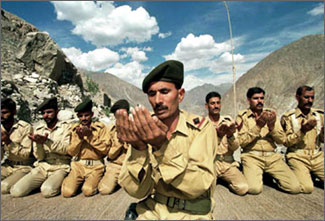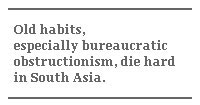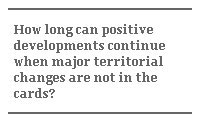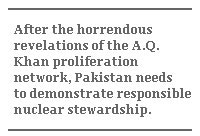A Thaw in South Asia? – Part I
A Thaw in South Asia? – Part I

SRINAGAR, Kashmir: A quiet anniversary was celebrated last month. For an entire year, Indian and Pakistani forces have observed a cease-fire along the Line of Control that divides Kashmir. Bilateral talks to improve relations are under way on eight topics, including Kashmir and nuclear risk reduction. For the first time ever, there is serious talk about a natural gas pipeline crossing Pakistan from Iran into the energy-starved states of western India. Another new initiative under consideration would allow travel across the Kashmir divide for separated family members, pilgrims, tourists, and traders. In December, nearly 600 athletes from both countries will compete in the first ever "Punjab Games."
The Kashmir dispute, labeled the "problem from hell" by former US Secretary of State Madeleine Albright, is thawing. How long the good news lasts is uncertain. Old habits, especially bureaucratic obstructionism, die hard in South Asia. Big obstacles to peacemaking remain, including extremists in both countries who will seek to blow up the process. No one has lost money betting against reconciliation on the subcontinent. And yet strangely positive developments are happening in South Asia, without much notice or impetus from outsiders.

President Pervez Musharraf has publicly strayed from Pakistan's unrealistic stand calling for a referendum to decide Kashmir's future. He now says that a solution acceptable to the Kashmiri people will be acceptable to Pakistan. Indian Prime Minister Manmohan Singh visited Kashmir in mid-November, promising a US$5 billion multi-year package of economic development. He has also signaled his interest in creative solutions - while ruling out a territorial settlement that hands Pakistan the highly contested and fabled Valley of Kashmir.
For almost six decades, Pakistan has failed to pry the Valley away from India by war, diplomacy and support of jihad. Musharraf insists that the Line of Control is part of the problem, not the solution. New Delhi insists a re-partition of the Subcontinent is out of the question. So why is Musharraf talking about a final settlement? And how long can positive developments continue when major territorial changes are not in the cards?

India's goal – a return to normalcy in Kashmir – is transparent; Musharraf's is not. In the corridors of power in New Delhi, Musharraf's diplomacy is viewed as grandstanding. Few believe that he is serious about seeking a realistic settlement – or able to sell one at home. Nonetheless, Indian government officials will pursue this process as far as Musharraf is willing or able, stressing the need for near-term steps to boost the exchange of people and goods.
In Srinagar, the violence-scarred summer capital of the Indian state of Jammu and Kashmir, public skepticism is directed against the Indian government, not Musharraf. New Delhi's US$5 billion offer fell flat, as three-quarters of the package is devoted to long-planned hydropower projects that will mostly benefit other Indian states. Meanwhile, power shortages continue to plague locals.
Musharraf's calls for new ideas and meeting half-way have struck a chord among disaffected Kashmiris. But Pakistan's willingness to jettison the referendum idea if India relaxes its rigidity over the Line of Control is a trade that no Indian leader can accept.

How serious and realistic is Musharraf about a settlement? Perhaps he is ill-informed about a feasible outcome in Kashmir. Or perhaps Musharraf's self-assurance is leading him to a dead end, just as in 1999, when he championed a scheme to seize the high ground above Kargil on India's side of the Kashmir divide. This misadventure resulted in US and international leaders affirming the "sanctity" of the status quo. Alternatively, Musharraf may once again be playing the role of the celebrated tightrope walker who enjoys the spotlight and engages in risky tactical maneuvers without thinking through his end game.
Conventional wisdom in New Delhi and Washington holds that the Pakistan Army needs the Kashmir dispute to justify its hold on the levers of national power. But the Army is already deeply entrenched in the workings of Pakistan's government and the economy. Its corporate interests also require a healthy national economy.
If this is the case, we must consider the possibility that Musharraf really is looking to turn the page on Kashmir. The search for a face-saving exit strategy makes sense if Musharraf understands that current Pakistani methods cannot wrest territorial gains in the Valley. New Delhi would be making a grave mistake not to explore this possibility, relying instead on cynical judgments about his game plan.

How sustainable is the current thaw? Already there are familiar signs of backsliding, with promising initiatives on the pipeline and on Kashmir's road openings becoming linked to other negotiating proposals. Progress can also become quickly stymied by horrific acts of violence – including another assassination attempt against Musharraf.
Even so, near-term prospects for progress look better than in decades. Both countries seem ready to take a breather from the succession of intense crises they have lived through since acquiring nuclear weapons 15 years ago. In addition, after the horrendous revelations of the proliferation network organized by A.Q. Khan, Pakistan needs to demonstrate responsible nuclear stewardship. This means that Islamabad has an interest in de-linking progress on nuclear risk-reduction measures from a Kashmir settlement. Pakistan also seeks significant arms transfers from the United States, including nuclear-capable F-16 combat aircraft. It makes little sense for Washington to arm Pakistan with offensive weapons if tensions are on the rise in South Asia.
In addition, New Delhi and Islamabad have placed a high priority on economic development in the years ahead. For the first time in the history of any nuclear rivalry, the prime ministers of both countries have backgrounds in economics. Musharraf hand-picked Shaukat Aziz, an investment banker, to pursue a growth strategy. Manmohan Singh is a developmental economist by training. India's economy is five times larger and growing at more than two percent faster than Pakistan's. Islamabad's support for the "freedom struggle" in Kashmir is not attractive to foreign investors or conducive to economic growth.
The prospect of a natural gas pipeline and travel across the Kashmir divide are the most interesting new developments in the Kashmir equation. Washington will oppose, but cannot successfully obstruct a pipeline originating in Iran, if New Delhi, Islamabad, and Tehran can reach an agreement that provides credible assurance of supply. Pipelines take years to construct, and financing can fall through if, in the interim, war clouds return to the horizon.
Well before a pipeline is constructed, the psychology of the Kashmir dispute could change markedly if Pakistan and India agree to open roads and trading posts along the Line of Control. The first road opening between Srinagar and Muzaffarabad, the capitals of Indian- and Pakistani-held Kashmir, could occur within months - if Musharraf is serious about facilitating outcomes that Kashmiris want. Only hard-core oppositionists on both sides of the Kashmir divide oppose this initiative.
Bridging the Kashmir dispute through transits and trade could have psychological effects that would be difficult to reverse. Opening the road is therefore a key indicator of progress, as well as Musharraf's intentions. New Delhi's willingness to proceed with the natural gas pipeline across Pakistan is a second key indicator that, at long last, significant progress might be possible in detoxifying the Kashmir dispute.
Michael Krepon is co-founder of the Henry L. Stimson Center. He is the author of Escalation Control and the Nuclear Option in South Asia and the editor of Nuclear Risk Reduction in South Asia.